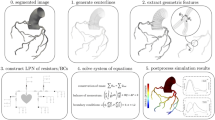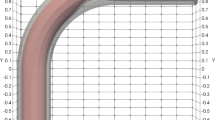Abstract
A distributed lumped parameter (DLP) model of blood flow was recently developed that can be simulated in minutes while still incorporating complex sources of energy dissipation in blood vessels. The aim of this work was to extend the previous DLP modeling framework to include fluid–structure interactions (DLP-FSI). This was done by using a simple compliance term to calculate pressure that does not increase the simulation complexity of the original DLP models. Verification and validation studies found DLP-FSI simulations had good agreement compared to analytical solutions of the wave equations, experimental measurements of pulsatile flow in elastic tubes, and in vivo MRI measurements of thoracic aortic flow. This new development of DLP-FSI allows for significantly improved computational efficiency of FSI simulations compared to FSI approaches that solve the full 3D conservation of mass and momentum equations while also including the complex sources of energy dissipation occurring in cardiovascular flows that other simplified models neglect.







Similar content being viewed by others
References
Alastruey J (2011) Numerical assessment of time-domain methods for the estimation of local arterial pulse wave speed. J Biomech 44(5):885–891. https://doi.org/10.1016/j.jbiomech.2010.12.002
Ambrosi D, Ateshian GA, Arruda EM et al (2011) Perspectives on biological growth and remodeling. J Mech Phys Solids 59(4):863–883
Barnard ACL, Hunt WA, Timlake WP, Varley E (1966) A theory of fluid flow in compliant tubes. Biophys J 6(6):717–724. https://doi.org/10.1016/S0006-3495(66)86690-0
Battista C, Bia D, Germán YZ et al (2016) Wave propagation in a 1d fluid dynamics model using pressure-area measurements from ovine arteries. J Mech Med Biol 16(02):1650007. https://doi.org/10.1142/S021951941650007X
Bellini C, Ferruzzi J, Roccabianca S et al (2014) A microstructurally motivated model of arterial wall mechanics with mechanobiological implications. Ann Biomed Eng 42(3):488–502. https://doi.org/10.1007/s10439-013-0928-x
Boccadifuoco A, Mariotti A, Celi S, et al (2016) Uncertainty quantification in numerical simulations of the flow in thoracic aortic aneurysms. In: ECCOMAS Congress 2016 - Proceedings of the 7th European Congress on Computational Methods in Applied Sciences and Engineering. National Technical University of Athens, pp 6226–6249
Boccadifuoco A, Mariotti A, Capellini K et al (2018a) Validation of numerical simulations of thoracic aorta hemodynamics: comparison with in vivo measurements and stochastic sensitivity analysis. Cardiovasc Eng Technol 9(4):688–706. https://doi.org/10.1007/s13239-018-00387-x
Boccadifuoco A, Mariotti A, Celi S et al (2018b) Impact of uncertainties in outflow boundary conditions on the predictions of hemodynamic simulations of ascending thoracic aortic aneurysms. Comput Fluids 165:96–115. https://doi.org/10.1016/j.compfluid.2018.01.012
Borazjani I, Ge L, Sotiropoulos F (2008) Curvilinear immersed boundary method for simulating fluid structure interaction with complex 3D rigid bodies. J Comput Phys 227(16):7587–7620. https://doi.org/10.1016/j.jcp.2008.04.028
Bozzi S, Morbiducci U, Gallo D et al (2017) Uncertainty propagation of phase contrast-MRI derived inlet boundary conditions in computational hemodynamics models of thoracic aorta. Comput Methods Biomech Biomed Engin 20(10):1104–1112. https://doi.org/10.1080/10255842.2017.1334770
Chow KW, Mak CC (2006) A simple model for the two dimensional blood flow in the collapse of veins. J Math Biol 52(6):733–744. https://doi.org/10.1007/s00285-005-0351-5
Figueroa CA, Vignon-Clemental IE, Jansen KE et al (2006) A coupled momentum method for modeling blood flow in three-dimensional deformable arteries. Comput Methods Appl Mech Eng 195(41–43):5685–5706. https://doi.org/10.1016/j.cma.2005.11.011
Gan CT, Lankhaar JW, Westerhof N et al (2007) Noninvasively assessed pulmonary artery stiffness predicts mortality in pulmonary arterial hypertension. Chest 132(6):1906–1912. https://doi.org/10.1378/chest.07-1246
Gundert TJ, Marsden AL, Yang W, Ladisa JF (2012) Optimization of cardiovascular stent design using computational fluid dynamics. J Biomech Eng. https://doi.org/10.1115/1.4005542
Kung EO, Les AS, Figueroa CA et al (2011) In vitro validation of finite element analysis of blood flow in deformable models. Ann Biomed Eng 39(7):1947–1960. https://doi.org/10.1007/s10439-011-0284-7
Liang L, Steinman DA, Brina O et al (2018) Towards the clinical utility of CFD for assessment of intracranial aneurysm rupture - a systematic review and novel parameter-ranking tool. J Neurointerv Surg 11(2):153–158. https://doi.org/10.1136/neurintsurg-2018-014246
Liu J, Marsden AL (2018) A unified continuum and variational multiscale formulation for fluids, solids, and fluid-structure interaction. Comput Methods Appl Mech Eng 337:549–597. https://doi.org/10.1016/j.cma.2018.03.045
Marsden AL, Esmaily-Moghadam M (2015) Multiscale modeling of cardiovascular flows for clinical decision support. Appl Mech Rev 67:11. https://doi.org/10.1115/1.4029909
Marsden AL, Feinstein JA (2015) Computational modeling and engineering in pediatric and congenital heart disease. Curr Opin Pediatr 27(5):587–596. https://doi.org/10.1097/MOP.0000000000000269
Milišić V, Quarteroni A (2004) Analysis of lumped parameter models for blood flow simulations and their relation with 1D models. ESAIM Math Model Numer Anal 38(4):613–632. https://doi.org/10.1051/m2an:2004036
Mirramezani M, Shadden SC (2020) A distributed lumped parameter model of blood flow. Ann Biomed Eng 48(12):4870–2886. https://doi.org/10.1007/s10439-020-02545-6
Morbiducci U, Mazzi V, Domanin M et al (2020) Wall shear stress topological skeleton independently predicts long-term restenosis after carotid bifurcation endarterectomy. Ann Biomed Eng 48(12):2936–2949. https://doi.org/10.1007/s10439-020-02607-9
Moré JJ (1978) The Levenberg-Marquardt algorithm: Implementation and theory. Springer, Berlin, Heidelberg, pp 105–116
O’Rourke MF, Avolio AP (1980) Pulsatile flow and pressure in human systemic arteries studies in man and in a multibranched model of the human systemic arterial tree. Circ Res 46(3):363–372
Olufsen MS (1999) Structured tree outflow condition for blood flow in larger systemic arteries. Am J Physiol Hear Circ Physiol 276(1):H257–H268. https://doi.org/10.1152/ajpheart.1999.276.1.H257
Parker KH (2009) An introduction to wave intensity analysis. Med Biol Eng Comput 47(2):175–188. https://doi.org/10.1007/s11517-009-0439-y
Pewowaruk R, Roldán-Alzate A (2019) 4D flow MRI estimation of boundary conditions for Patient specific cardiovascular simulation. Ann Biomed Eng 47(8):1786–1798. https://doi.org/10.1007/s10439-019-02285-2
Resnick N, Yahav H, Shay-Salit A et al (2003) Fluid shear stress and the vascular endothelium: for better and for worse. Prog Biophys Mol Biol 81(3):177–199
Reymond P, Merenda F, Perren F et al (2009) Validation of a one-dimensional model of the systemic arterial tree. Am J Physiol - Hear Circ Physiol 297(1):208–222. https://doi.org/10.1152/ajpheart.00037.2009
Ruesink T, Medero R, Rutkowski D, Roldán-Alzate A (2018) In vitro validation of 4D flow MRI for local pulse wave velocity estimation. Cardiovasc Eng Technol 9(4):674–687. https://doi.org/10.1007/s13239-018-00377-z
Sherwin SJ, Franke V, Peiró J, Parker K (2003) One-dimensional modelling of a vascular network in space-time variables. J Eng Math 47:217–250. https://doi.org/10.1023/B:ENGI.0000007979.32871.e2
Steinman DA, Migliavacca F (2018) Editorial special issue on verification validation and uncertainty quantification of cardiovascular models towards effective VVUQ for translating cardiovascular modelling to clinical utility. Cardiovasc Eng Technol 9(4):539–543. https://doi.org/10.1007/s13239-018-00393-z
Taylor CA, Steinman DA (2010) Image-based modeling of blood flow and vessel wall dynamics: applications, methods and future directions: Sixth International Bio-Fluid Mechanics Symposium and Workshop, March 28–30, 2008 Pasadena. California Ann Biomed Eng 38(3):1188–1203. https://doi.org/10.1007/s10439-010-9901-0
Valentín A, Cardamone L, Baek S, Humphrey JD (2009) Complementary vasoactivity and matrix remodelling in arterial adaptations to altered flow and pressure. J R Soc Interface 6(32):293–306. https://doi.org/10.1098/rsif.2008.0254
Valentín A, Humphrey JD, Holzapfel GA (2013) A finite element-based constrained mixture implementation for arterial growth, remodeling, and adaptation: Theory and numerical verification. Int j Numer Method Biomed Eng 29(8):822–849. https://doi.org/10.1002/cnm.2555
Van De Vosse FN, Stergiopulos N (2011) Pulse wave propagation in the arterial tree. Annu Rev Fluid Mech 43:467–499. https://doi.org/10.1146/annurev-fluid-122109-160730
Westerhof N, Bosman F, De Vries CJ, Noordergraaf A (1969) Analog studies of the human systemic arterial tree. J Biomech 2(2):121–143. https://doi.org/10.1016/0021-9290(69)90024-4
Xiao N, Alastruey J, Alberto Figueroa C (2014) A systematic comparison between 1-D and 3-D hemodynamics in compliant arterial models. Int J Numer Method Biomed Eng 30(2):204–231. https://doi.org/10.1002/cnm.2598
Zambrano BA, McLean NA, Zhao X et al (2018) Image-based computational assessment of vascular wall mechanics and hemodynamics in pulmonary arterial hypertension patients. J Biomech 68:84–92. https://doi.org/10.1016/j.jbiomech.2017.12.022
Zamir M (2000) The physics of pulsatile flow. AIP Press; Springer, New York
Zhang Y, Barocas VH, Berceli SA et al (2016) Multi-scale modeling of the cardiovascular system: disease development, progression, and clinical intervention. Ann Biomed Eng 44(9):2642–2660. https://doi.org/10.1007/s10439-016-1628-0
Acknowledgements
This investigation was supported under the NIH Ruth L. Kirschstein National Research Service Award T32 HL 007936 from the National Heart Lung and Blood Institute to the University of Wisconsin-Madison Cardiovascular Research Center (RP). The content is solely the responsibility of the authors and does not necessarily represent the official views of the NIH.
Author information
Authors and Affiliations
Corresponding author
Additional information
Publisher's Note
Springer Nature remains neutral with regard to jurisdictional claims in published maps and institutional affiliations.
Appendix
Appendix
1.1 Symmetry of forward vs. backward traveling waves
By considering the “convergence” of 0D models to 1D models it has previously been shown that the classical lumped parameter model dissipates forward traveling waves while amplifying backward traveling waves (Milišić and Quarteroni 2004). The analysis begins by assuming that the 1D linear system (Eq. 3) is replaced by a series of 0D models with length \({\Delta }x\). For the classical lumped parameter model this series of 0D models can be written as (Fig.
8)
where C’, L’, and R’ are the vessel’s compliance, impedance, and resistance per unit length. This can be regarded as a first-order finite difference approximation of 1D linear system.
Utilizing the “water hammer” equations (Milišić and Quarteroni 2004; Parker 2009)
the 1D linear system can be rewritten as
where w and z are called the characteristic variables and physically represent the pressure of the forward and backwards traveling waves.
The finite difference scheme (Eq. 44) can similarly be rewritten for characteristic variables as
which correspond to a centered finite difference discretization of the characteristic system (Eq. 46) with the addition of two terms that scale with \({\Delta }x\), a dissipative term in the first equation and an anti-dissipative term in the second equation. This asymmetry indicates that the classical lumped parameter circuit artificially dampens forward traveling waves while amplifying backward traveling waves.
In our lumped parameter scheme the pressure drop between nodes is due to the average flow between those two nodes so a series of 0D models can be written as
which correspond to a centered finite difference approximation of the 1D linear system where the average flowrate between nodes is defined at the segment midpoint. Recognizing that the lumped parameter model was derived by assuming linear interpolation of pressure between nodes (\(P_{{i + \frac{1}{2}}} = \frac{1}{2}\left( {P_{i} + P_{i + 1} } \right)\), the system of Eqs. 48 can also be rewritten in terms of the characteristic variables (w and z)
which is a centered finite difference approximation of the characteristic equation (Eq. 46). Importantly, the system of Eqs. 49 does not contain the dissipative and antidissipative terms that resulted from the classical lumped parameter model (Eq. 47). This result indicates that our lumped parameter model does not asymmetrically treat forward and backward traveling waves. The asymmetry of the classical lumped parameter model is visually appreciated by looking at the numerical stencils of the finite difference approximations generated by the classical lumped parameter model (Eq. 44) and our symmetric lumped parameter model (Eq. 48).
1.2 Rigid-walled DLP model
The rigid wall DLP model used in the in vivo validation case was implemented as by enforcing mass conservation at vascular junctions
and conserving momentum over each vascular junction
where the impedance term L is calculated with Eq. 5 and the nonlinear resistance term R is calculated with Eq. 24. A schematic representation of the rigid DLP model would be similar to Fig. 3b, but without only the resistors and inductors.
Rights and permissions
About this article
Cite this article
Pewowaruk, R., Roldán-Alzate, A. A distributed lumped parameter model of blood flow with fluid-structure interaction. Biomech Model Mechanobiol 20, 1659–1674 (2021). https://doi.org/10.1007/s10237-021-01468-y
Received:
Accepted:
Published:
Issue Date:
DOI: https://doi.org/10.1007/s10237-021-01468-y





